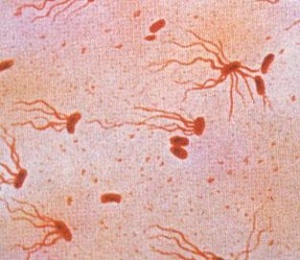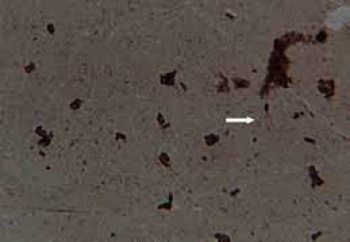Flagella Stain - Principle, Purpose, Reagents, Procedure, Result, Interpretation
Introduction to Flagella Stain
Flagella Stain is recommended for the detection of the presence and arrangement of flagella on bacterial cells for presumptive identification of motile bacterial species – recently anaerobic bacteria. Bacteria may be motile by a variety of mechanisms – the most common one being flagella.
This is a simple, rapid, and qualitative procedure for visualization of flagellar shape, curvature, arrangement, length, and number.
Principle of flagella stain
The bacterial flagella is narrow in diameter and hence cannot be seen with a light microscope. During flagella staining, the bacterial flagella can be viewed by use of the primary stain - crystal violet in an alcoholic solution. After the alcoholic solution evaporates during the staining procedure, a precipitate is left around the flagella. As a result, the apparent size of the flagella increases in the human eye.
Mordants used for flagella stain include tannic acid and aluminum potassium phosphate. Phenol can be used as an anti-fungal agent.

Bacillus cereus (Source: CDC)
History of flagella stain
In 1877, Robert Koch developed a stain for bacterial flagella. Subsequently, several methods for flagella staining were published. Leifson published a simple flagella stain procedure in 1930 while in 1958, a silver-plating stain for flagella was developed, which was simplified in 1977.
Recently, fluorescent protein stains such as NanoOrange have been used to visualize bacterial flagella using light microscopy.
Purpose of flagella stain
The purpose of flagella stain is to stain bacterial flagella to reveal the presence or absence of flagella i.e. atrichous (nonmotile, without flagella). This process also discloses the arrangement and location of flagella on the perimeter of the cell.
The presence/absence of flagella characterizes bacteria phenotypically as not all bacteria have flagella at the same location. Bacterial species may be monotrichous (single polar flagellum), lophotrichous (tufts of flagella at each pole), amphitrichous (one or more flagella at both poles), peritrichous (flagella surrounding the perimeter of the cell.

Salmonella Typhi (source: ReserchGate)
Reagents for flagella stain
For flagella staining, Leifson flagella stain can be prepared by following instructions or commercially available reagents can be purchased. Eg: Presque Isle Cultures
Leifson flagella stain
Solution A:
Distilled water - 100 ml
Sodium Chloride - 1.5 g
Solution B:
Tannic acid - 3 g
Distilled water - 100 ml
Solution C:
Paraosanilline hydrochloride - 0.3 g
Pararosaniline acetate - 0.9 g
Ethanol, 95% (vol/vol) - 100ml
Instructions:
Mix equal volumes of solution A and solution B and add two volumes of the mixture to 1 volume of solution C. The staining solution can be kept in a refrigerator for 1 to 2 months.
Presque Isle Cultures flagella stain:
Solutions of Presque Isle Cultures are proprietary. Two solutions can be purchased – Flagella mordant (solution I) and silver stain (solution II).
Both solutions can be stored at room temperature for several weeks.
Procedure of flagella stain
Preparation of cultures:
For flagella staining, both solid and liquid media cultures can be used. Cultures incubated between 16 to 20 hours must be used as older cultures lose flagella.
E.g.: Bacillus sp. Undergo spore formation and lose flagella during the development process.
If centrifugation is required in liquid cultures (for suspension) or in solid cultures (culture clumps), it should be done gently as flagella are easily sheared.
From agar plate:
With a sterile inoculating loop, remove a small amount of growth (one-fourth of the colony) from the agar plate or slant culture to prepare a suspension.
Gently emulsify it in 100 ml of distilled water in a microcentrifuge tube.
* the inoculum must be only slightly cloudy as too much inoculum will result in an inability to visualize the flagella
From liquid culture:
Place 100 ml of fresh liquid culture in a microcentrifuge tube.
Centrifuge and remove the spent medium.
Resuspend in 100 ml of distilled water by vortexing, centrifuging, and removing the supernatant.
In 200 ml of distilled water, emulsify to form a slightly cloudy emulsion and gently vortex.
* The emulsion must be only slightly cloudy as too much inoculum will result in an inability to visualize the flagella
Preparation of slides:
Wipe a new microscope slide with 95% ethanol and flame to dry.
After labeling, place 5 to 10 ml of culture emulsion on one end of the microscope slide with a micropipettor.
Spread the emulsion using the same pipette tip held parallel to the microscope slide.
Allow to air dry at room temperature as heat fixation will destroy the proteinaceous flagella structure.
Flagella Staining
By Leifson flagella stain
Take the prepared slide and mark the dried sample by drawing a rectangle around it with a wax pencil.
Place the slide on the staining rack flood the insides of the rectangle mark it with Leifson dye solution.
Leave it at room temperature for 7 to 15 minutes.
After a golden film develops on the dye surface and precipitate appears throughout the sample, gently wash the slide with running tap water.
Air dry and view under oil immersion, at 1,000x magnification, using bright-field microscopy.
Both bacteria and flagella are stained red.
By Presque Isle Cultures flagella stain
Take a prepared slide and place it on a staining rack.
Flood the slide with Presque Isle Cultures Solution I i.e. the mordant.
Leave at room temperature for 4 minutes.
Rinse gently with distilled water and shake excess water from the slide.
Flood the slide with Presque Isle Cultures Solution II i.e. the silver stain.
Heat the slide over the bunsen burner by back-and-forth movement until steam is emitted.
* care should be taken not to overheat the slide as excess heat will destroy proteinaceous flagella
Leave it at room temperature for 4 minutes.
Gently rinse with distilled water.
Blot dry with the help of bibulous paper.
View under oil immersion, at 1,000x magnification, using bright-field microscopy.
Both bacteria and flagella stain golden brown.

Pseudomonas (Source: ASM)
Result, Interpretation of flagella stain
The result and interpretation of flagella stain are completed by following terms:
Presence or absence of flagella
Number of flagella per bacterial cell
Location of flagella
Peritrichous
Polar
Lophotrichous
The amplitude of the wavelength
Short
Long
Whether or not “tufted”